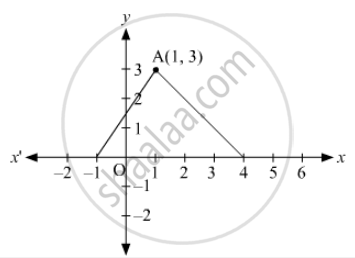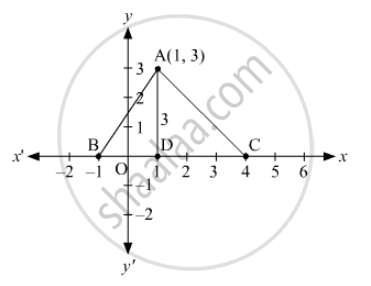Advertisements
Advertisements
प्रश्न
In Fig. 14.46, the area of ΔABC (in square units) is

पर्याय
15
10
7.5
2.5
उत्तर

The coordinates of A are (1, 3).
∴ Distance of A from the x-axis, AD = y-coordinate of A = 3 units
The number of units between B and C on the x-axis are 5.
∴ BC = 5 units
Now,
Area of ∆ABC = \[\frac{1}{2} \times BC \times AD = \frac{1}{2} \times 5 \times 3 = \frac{15}{2} = 7 . 5\] square units
Thus, the area of ∆ABC is 7.5 square units.
APPEARS IN
संबंधित प्रश्न
Prove that the points (3, 0), (4, 5), (-1, 4) and (-2, -1), taken in order, form a rhombus.
Also, find its area.
Find the coordinates of the point which divides the line segment joining (−1,3) and (4, −7) internally in the ratio 3 : 4
In what ratio does the point (−4, 6) divide the line segment joining the points A(−6, 10) and B(3,−8)?
The midpoint of the line segment joining A (2a, 4) and B (-2, 3b) is C (1, 2a+1). Find the values of a and b.
Find the ratio in which the point (-1, y) lying on the line segment joining points A(-3, 10) and (6, -8) divides it. Also, find the value of y.
ABCD is rectangle formed by the points A(-1, -1), B(-1, 4), C(5, 4) and D(5, -1). If P,Q,R and S be the midpoints of AB, BC, CD and DA respectively, Show that PQRS is a rhombus.
If the point C(k,4) divides the join of A(2,6) and B(5,1) in the ratio 2:3 then find the value of k.
Find the coordinates of the centre of the circle passing through the points P(6, –6), Q(3, –7) and R (3, 3).
A point whose abscissa and ordinate are 2 and −5 respectively, lies in
The distance of the point P (4, 3) from the origin is
If the point P (m, 3) lies on the line segment joining the points \[A\left( - \frac{2}{5}, 6 \right)\] and B (2, 8), find the value of m.
The perimeter of the triangle formed by the points (0, 0), (0, 1) and (0, 1) is
The coordinates of a point on x-axis which lies on the perpendicular bisector of the line segment joining the points (7, 6) and (−3, 4) are
Any point on the line y = x is of the form ______.
In which quadrant does the point (-4, -3) lie?
Which of the points P(-1, 1), Q(3, - 4), R(1, -1), S (-2, -3), T(-4, 4) lie in the fourth quadrant?
Students of a school are standing in rows and columns in their playground for a drill practice. A, B, C and D are the positions of four students as shown in figure. Is it possible to place Jaspal in the drill in such a way that he is equidistant from each of the four students A, B, C and D? If so, what should be his position?
Signs of the abscissa and ordinate of a point in the second quadrant are respectively.
The point at which the two coordinate axes meet is called the ______.
